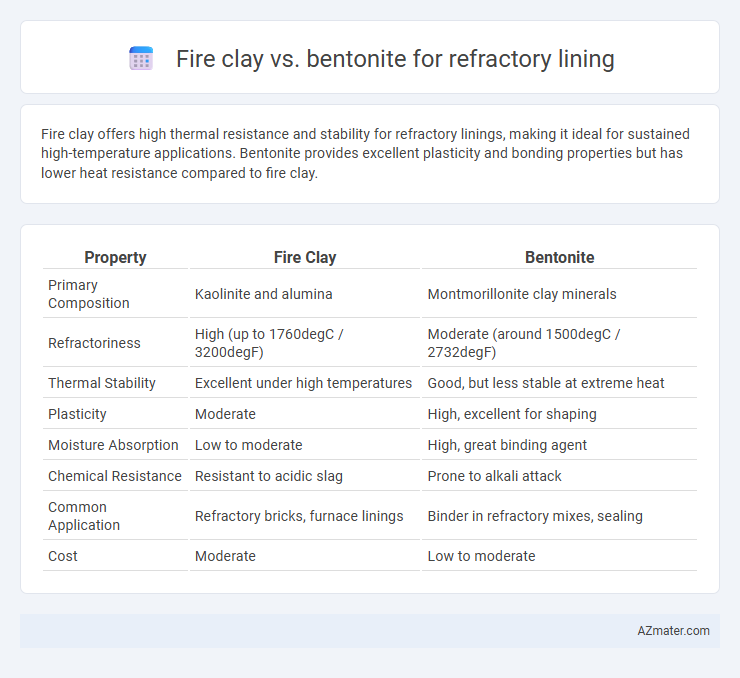Fire clay offers high thermal resistance and stability for refractory linings, making it ideal for sustained high-temperature applications. Bentonite provides excellent plasticity and bonding properties but has lower heat resistance compared to fire clay.
Table of Comparison
| Property | Fire Clay | Bentonite |
|---|---|---|
| Primary Composition | Kaolinite and alumina | Montmorillonite clay minerals |
| Refractoriness | High (up to 1760degC / 3200degF) | Moderate (around 1500degC / 2732degF) |
| Thermal Stability | Excellent under high temperatures | Good, but less stable at extreme heat |
| Plasticity | Moderate | High, excellent for shaping |
| Moisture Absorption | Low to moderate | High, great binding agent |
| Chemical Resistance | Resistant to acidic slag | Prone to alkali attack |
| Common Application | Refractory bricks, furnace linings | Binder in refractory mixes, sealing |
| Cost | Moderate | Low to moderate |
Introduction to Refractory Lining Materials
Fire clay and bentonite are essential refractory lining materials known for their high heat resistance and structural stability in industrial furnaces and kilns. Fire clay, rich in alumina and silica, provides excellent thermal shock resistance and mechanical strength, making it ideal for lining heat-intensive environments. Bentonite, primarily composed of montmorillonite clay, offers superior plasticity and binding properties, enhancing the integrity and durability of refractory bricks under extreme temperatures.
What is Fire Clay? Composition and Properties
Fire clay is a highly heat-resistant material composed primarily of hydrous aluminum silicates, commonly found in refractory linings for furnaces and kilns. Its composition typically includes alumina (Al2O3) ranging from 25% to 35% and silica (SiO2) between 50% and 60%, providing excellent thermal stability and resistance to thermal shock. The inherent plasticity and chemical inertness of fire clay make it ideal for shaping and maintaining structural integrity under extreme temperatures.
What is Bentonite? Composition and Properties
Bentonite is a natural clay composed primarily of montmorillonite, a member of the smectite group, known for its exceptional swelling and binding properties due to its high cation exchange capacity. Its fine-grained, plastic texture allows it to form a dense, impermeable refractory lining when mixed with fire clay, enhancing thermal insulation and mechanical strength. Bentonite's high melting point, chemical inertness, and excellent thermal shock resistance make it a crucial additive in refractory linings for furnaces and kilns.
Thermal Performance: Fire Clay vs Bentonite
Fire clay offers superior thermal stability and resistance to high temperatures, making it ideal for refractory linings exposed to extreme thermal cycling. Bentonite, while effective as a binding agent, has lower thermal conductivity and can degrade at temperatures above 800degC, limiting its use in high-temperature applications. Fire clay's low thermal expansion and high melting point enhance durability and insulation efficiency in refractory linings compared to bentonite.
Mechanical Strength Comparison
Fire clay offers moderate mechanical strength with thermal stability up to 1600degC, making it suitable for general refractory linings. Bentonite, primarily used as a binder in refractory mixes, enhances cohesion but exhibits lower intrinsic mechanical strength compared to fire clay. The superior compressive strength and abrasion resistance of fire clay-based linings ensure better durability under mechanical stress in high-temperature environments.
Chemical Resistance and Durability
Fire clay exhibits superior chemical resistance against acidic slags and moderate alkalis due to its high alumina and silica content, making it well-suited for refractory linings exposed to varied chemical environments. Bentonite offers excellent plasticity and thermal shock resistance but tends to have lower chemical resistance, especially in corrosive or highly alkaline conditions, which can affect its durability over time. Fire clay's durability in refractory applications is enhanced by its low porosity and strong bonding, whereas bentonite may require additives to improve long-term stability under aggressive chemical exposure.
Installation and Workability of Each Material
Fire clay offers excellent workability with easy molding and shaping during refractory lining installation, making it ideal for complex shapes and repairs owing to its plasticity and high temperature resistance. Bentonite, while providing strong bonding properties and minimal shrinkage, can be more challenging to install due to its higher moisture content and tendency to absorb water, requiring careful moisture control and compaction for optimal lining strength. Fire clay's quicker setting time reduces downtime during installation, whereas bentonite may need longer curing periods to achieve desired refractory performance.
Cost Analysis: Fire Clay vs Bentonite
Fire clay offers a cost-effective solution for refractory linings due to its abundant availability and lower processing expenses compared to bentonite. Bentonite, while providing superior plasticity and better adhesion properties, typically incurs higher costs stemming from its specialized mining and refining processes. For industrial applications prioritizing budget constraints, fire clay provides a more economical choice without significantly compromising on thermal performance.
Typical Applications in Refractory Lining
Fire clay is commonly used for refractory linings in furnaces, kilns, and boilers due to its high resistance to thermal shock and ability to withstand temperatures up to 1600degC. Bentonite is primarily utilized as a bonding agent in refractory bricks and castables, enhancing plasticity and cohesiveness for shaped and unshaped refractory linings in steelmaking and foundry applications. Both materials contribute to the durability and mechanical strength of linings, with fire clay favored for structural components and bentonite for improving moldability and adhesion.
Choosing the Right Material for Your Project
Fire clay offers excellent heat resistance and structural integrity for refractory linings, making it suitable for applications with moderate thermal exposure and mechanical stress. Bentonite, rich in swelling montmorillonite clay minerals, provides superior plasticity and bonding properties, ideal for molding and sealing refractory shapes but generally has lower heat resistance compared to fire clay. Choosing the right material depends on specific project requirements such as operating temperature, mechanical load, and desired durability, with fire clay favored for high-temperature stability and bentonite preferred for binding and shaping refractory components.

Infographic: Fire clay vs Bentonite for Refractory lining
 azmater.com
azmater.com